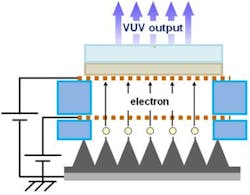| A compact lamp combines a carbon-nanofiber cold-cathode emitter with a potassium magnesium fluoride phosphor to create VUV light. (Credit: S. Ono -- Nagoya Institute of Technology) |
A team of Japanese and Malaysian researchers has developed a small vacuum-ultraviolet (VUV)-emitting lamp that combines a carbon-nanofiber (CNF) cold-cathode field emitter with a thin-film potassium magnesium fluoride (KmgF3) phosphor that emits light at 140 to 220 nm wavelengths, with emission peaks at the 155 and 180 nm wavelengths. The small, efficient lamp could be used for many industrial and medical processes, including sterilizing medical devices and cleaning semiconductor substrates.1
The team includes members from the Nagoya Institute of Technology (Nagoya, Japan), Universiti Teknologi Malaysia (Johor, Malaysia) Tokuyama Corporation (Tokyo, Japan), Tohoku University (Sendai, Japan), and Kyushu Institute of Technology (Kitakyushu, Japan).
Pre-existing commercial VUV lamps are bulky and expensive. They also use a lot of power, run hot, have short lifetimes and contain toxic gases. The new lamp uses no gases for its operation (just a small vacuum chamber). In AIP Publishing's journal APL Materials, the Japanese team describes how this solid-state phosphor promises to make future, low-power VUV lamps that will be more flexible in design as well as being smaller, longer lasting and relatively heat-free.
"Our lamp is a promising light source in terms of lifetime, size, heat conduction, and stability," says Shingo Ono of the Nagoya Institute of Technology in Japan, who led the research. "[It] has the potential to be an excellent alternate light source to low-pressure mercury lamps, excimer lamps, and deuterium lamps."
One of the hurdles they faced was to safely fabricate the phosphor using a compound containing fluoride, which is itself a toxic, corrosive and potentially dangerous chemical to handle. One way would have been to use an inflow of gaseous fluoride to coat the surface of the KMgF3 thin film, but instead the team discovered a safer route to fabricating it with pulsed-laser deposition.
Source: http://www.aip.org/publishing/journal-highlights/vacuum-ultraviolet-lamp-future-created-japan
REFERENCE:
1. Masahiro Yanagihara et al., APL Materials (2014); http://dx.doi.org/10.1063/1.4871915
